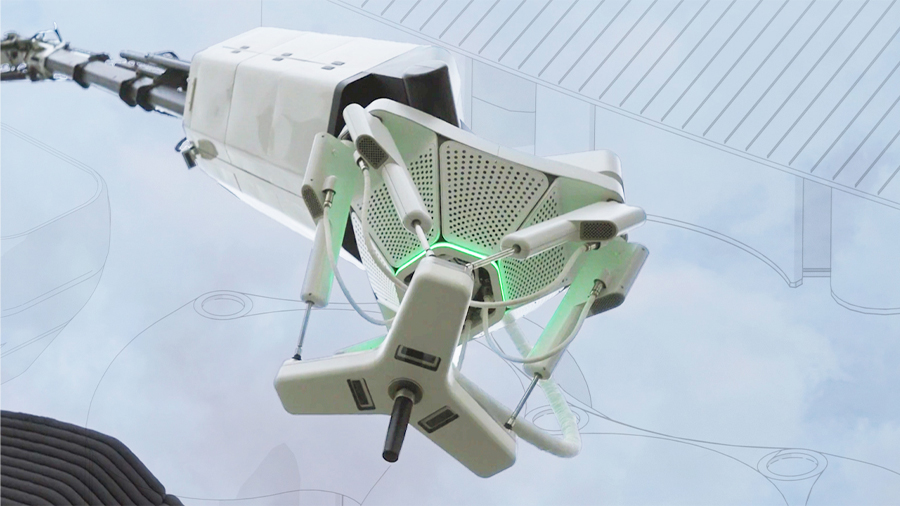Homebuilding innovator ICON is laying the groundwork for affordable, 3D-printed homes in Community First! Village with support from Wells Fargo.
NORTHAMPTON, MA / ACCESSWIRE / June 20, 2024 / Around the world, communities are asking the same question: How do we make housing more accessible to everyone? One solution is to build differently, from the ground up.
Inside the Community First! Village outside of Austin, Texas, one such homebuilding tool has taken shape: one of the country's first occupied 3D-printed homes. But they're far from the last.
With some help from Wells Fargo, rapidly developing robotic 3D-printing technology is being combined with cutting-edge design and community-building to help address the housing gap. The result will be 3D-printed homes that are more resilient and imaginative in the face of climbing homebuilding costs and global crises like climate change.
"Housing alone will never solve homelessness, but community will. I think what you see in Community First! Village is the manifestation of community. We need community, that human to human, heart to heart," said Alan Graham, founder and CEO of Mobile Loaves & Fishes, whose supportive neighborhood outside of Austin houses more than 370 people coming out of chronic homelessness.
In 2020, the nonprofit partnered with Austin-based ICON, a construction technology company, to build 3D-printed homes for some of its residents. Now that partnership is growing with Initiative 99. The international design competition tasks architects to create a new kind of affordable home that's only possible through 3D printing for a construction price tag of $99,000 or less, and are also resilient, dignified, and environmentally friendly. The first phase culminated at SXSW in Austin, where ICON announced six winning designs from around the world. With a $500,000 grant from the Wells Fargo Foundation, one or more of those designs will be built at scale within an upcoming Community First! Village expansion.
Plus, all the winning designs are available for homebuilders and architects across the nation to use to create high-quality affordable housing in their own communities via ICON's digital home catalog, CODEX. Darlene Goins, president of the Wells Fargo Foundation and head of Philanthropy and Community Impact at Wells Fargo, said the competition is a "gamechanger for the housing industry," which will push the envelope for designing lower-cost, quality housing for the people and families who need it most.
"These international design competitions don't usually happen for affordable housing," said ICON co-founder and CEO Jason Ballard. "The hope is that dozens and dozens, if not hundreds or thousands, of homes come into the world because of Initiative 99."
What are the benefits of a 3D-printed home?
ICON develops large-scale robotics, software, and advanced materials to build homes faster and more affordably. Their Vulcan construction systems, for example, weighing in at roughly one-ton, automate construction of their characteristically layered walls, while roofs, windows, and doors are built using traditional methods.
3D-printed homes can be built faster and for less money
A recently unveiled multi-story robotic construction system called Phoenix introduces the capability of printing an entire building enclosure including foundations and roof structures. By increasing speed and size and decreasing setup time and the number of required operators, this advanced robotic system will reduce ICON printing costs by half.
Ultimately, there could be a "quantum leap" in reducing housing costs, Ballard said.
"We finally have a solution for the global housing crisis to speed things up and produce the housing that we need," said I99 winner Mona Peters.
3D-printed homes create new design possibilities
ICON's printers specialize in building curved and bespoke designs quickly and more economically compared to traditional methods because 3D printers streamline a home's design and build materials.
For example, I99 winner Victoria Roznowski added adaptable sleeping areas and a wavy exterior in her winning design, which she envisioned serving refugees in her native Germany.
"I truly believe 3D printing can revolutionize the way we're building houses right now," she said.
3D printing promotes resilient and sustainable homebuilding
These homes don't just promote sustainability through efficient automation, but in their building materials, too. For example, ICON's robotic printers dispense the company's own formulation of low-carbon concrete.
The startup says its homes produce far less waste than the four tons left over after building the average home in the U.S. Many of the I99 designs go further to promote water conservation, efficiently scaled communities, and other sustainable features.
How to 3D print your own home
Interested in your own 3D-printed home? Try an open-sourced design.
ICON's CODEX is a home design catalog of ready-to-print architecture plans for developers, architects, and homebuyers. Among the dozens of available designs in the catalog are the six I99 phase 1 winners. Other categories focus on storm- and fire-resilient homes, Texan architecture, and more.
If you like a design, you or your architect can reach out to ICON or take a virtual tour. The company has 3D-printed homes on the market.

Tech startup ICON engineers innovative homebuilding tools, such as the multi-story 3D printing robot Phoenix (pictured), to bring down project costs and make housing more accessible.
View additional multimedia and more ESG storytelling from Wells Fargo on 3blmedia.com.
Contact Info:
Spokesperson: Wells Fargo
Website: https://www.3blmedia.com/profiles/wells-fargo
Email: [email protected]
SOURCE: Wells Fargo




